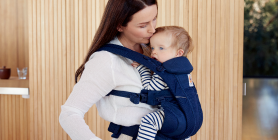You knew your baby would cry. But did you know how frustrating crying can become? What do you do when you have tried everything you could think of to comfort him and nothing worked? A crying baby can be frustrating but no one thinks they will shake their infant. Research confirms what Marilyn Barr, Founder and Executive Director of the National Center on Shaken Baby Syndrome, says, “Frustration with a baby’s crying is the number one trigger for shaking, and the stress of handling a crying baby can seem overwhelming.” Hospitals and organizations nationwide are responding by educating parents about the period of “purple” crying, a stage when normal, perfectly healthy babies can cry for five hours a day or more. Babies sometimes need to cry even when nothing is wrong since crying is the only way they have to tell you if they are hungry, sad, or uncomfortable. Some parents will automatically interpret the sound of the cry and know what to do. But they, too, can be overwhelmed during a sleepless night of crying. Shaken Baby Syndrome is defined as “Brain injuries that result from vigorous shaking of an infant or young child held by the chest, shoulders, or extremities causing extreme rotational cranial acceleration. It is characterized by the intracranial and intraocular hemorrhages with no evidence of external trauma. Serious cases may result in death.” It is the most severe form of child abuse and accounts for the majority of severe head injuries in children less than one year old. Statistics show that one shaken baby in 4 dies. Some studies estimate that 15% of children’s deaths are due to battering or shaking, and an additional 15% are possible cases of shaking. More than 60% of the victims are male. Natural parents are 50% of offenders; 17% are non-relatives; 17% are mother’s boyfriend; 6% are step parents; 10% other. Almost 60% of the perpetrators are male. The median age of acute admission to hospitals is 2.2 months. Cases are more common in urban regions and in autumn and winter months. The condition has 15 – 35% mortality rate with half of the survivors suffering permanent neurological damage leading to blindness, seizures, development delays and spasticity. This type of trauma is being addressed by hospital-based parent education programs on Shaken Baby Syndrome. Since 2000 statewide legislative mandates have been adopted by a series of children’s hospitals in 12 states: Utah, Florida, Pennsylvania, Texas, Minnesota, Missouri, New York, Wisconsin, Illinois, Ohio, South Carolina and Massachusetts. In 2006, the Massachusetts Department of Health was one of the first of the 12 states to have a legislative mandate for such programs and has achieved an impressive 50% reduction in abusive head injuries. The Massachusetts Department of Health instituted a pilot program in 2010 to prevent “shaken baby” by utilizing baby carriers to promote dads bonding with their babies. Classes are held with five groups throughout the state. The Upstate New York SBS Education program began in December 1998 and was enacted into law in 2004, and involves 17 counties. Over seven years, their program has also resulted in a sustained 50% reduction in abusive head injuries in the region. Educational materials are provided to both parents at the birth of every child in the region, asking them to sign a commitment statement that affirms their receipt and understanding of the material. All hospitals in the combined 17 counties are participating and there have been over 120,000 statements returned by 2010. The SBS education program is now in partnership with pediatric care providers in the 17 counties that involves additional materials provided at the first doctor’s visit. The program is now serving as a model of prevention for numerous other programs worldwide. It was presented at a conference in Auckland, New Zealand where a version of the program is being implemented for their entire country. When the American economy began to struggle, additional stressors appeared for families. A study was conducted by a group of researchers at Children’s Hospital of Pittsburg that showed a relationship between the weakening economy and the rise of incidents of shaken baby syndrome/abusive head trauma. Data recorded from four Hospitals (in Pittsburg, PA; Cincinnati, OH; Columbus, OH and Seattle, WA) between January 2004 and June 2009 show that the number of cases rose from 4.8 per month prior to Dec. 1, 2007 (defined as the start of the recession) to 9.3 after that date. Marilyn Barr said, “The results of the study are very concerning and highlight the need for increased prevention efforts during times of economic hardship. Frustration with a baby’s crying is the number one trigger for shaking and the stress of handling a crying infant can be overwhelming.” Here are some ways to help your baby:
- If you haven’t purchased a baby carrier, you might want to. Research shows that the more a baby is held and carried, the less the baby will cry and fuss. One study found by 43% during the day and 51% at night.
- Check to see if your baby is hungry, too hot or too cold, or needs a diaper change.
- Check to see if your baby is sick or has a fever.
- Feed your baby slowly and burp often.
- Touch your baby, skin- to-skin contact will help soothe and relax both you and your baby.
- While sitting, lie your baby face down across your knees and gently pat or rub its back.
- Use a rocking chair, a good old time remedy.
- Swaddle your baby in a soft blanket.
- Play soft music, sing or hum a lullaby to your baby.
- Take your baby for a ride in the stroller or car.
“Take a Break, Don’t Shake” can prevent this severe form of physical child abuse. It is okay to place your baby in a safe spot, if it will just not stop crying, and leave it to cry while you take a break. Once you have relaxed for 5-10 minutes you will feel better and can go back to trying to soothe your baby. Inconsolable crying is a normal developmental behavior in infants. The problem is not the crying; it’s how caregivers respond to it. Shaking is never an appropriate response. Everyone from caregivers to bystanders can do something to prevent SBS.
Emotional Benefits of Getting Outside
Spending time in nature with your baby can strengthen the bond between you. The simple act of holding your baby close, feeling their warmth, and sharing new experiences together can create strong emotional connections. It’s also a wonderful way to reduce stress and improve your mood. When my littles were extra fussy, I’d take a walk around the neighborhood. Even though I don't live in an area with trails and surrounded by nature, simply behind outside changed everything. A little vitamin D does wonders!
Cognitive Development
Nature is a sensory wonderland for babies. The different sights, sounds, and smells can stimulate your baby’s senses and promote cognitive development. Watching leaves rustle, hearing birds chirp, and feeling the texture of a tree bark can all contribute to their learning and development.
All About Baby Carriers for Nature Adventures
Choosing the Right Baby Carrier
When it comes to selecting the best baby carrier for summer adventures, there are several options to consider.
Types of Baby Carriers:
- Wraps: Perfect for newborns, providing a snug and secure fit.
- Slings: Ideal for quick and easy use, offering good ventilation.
- Soft Structured Carriers: Versatile and comfortable for both parent and baby, suitable for longer trips.
Factors to Consider:
- Baby’s Age and Weight: Ensure the carrier is appropriate for your baby’s size and weight. For example, Ergobaby’s Embrace Newborn Carrier is perfect for the fourth trimester where baby is small and you’re looking for an easy way to stay close. As they grow, you’ll want to upgrade to an all-position carrier that’s meant for growing babies.
- Parent’s Comfort and Ergonomics: Look for carriers with padded shoulder straps and lumbar support if you’re planning on longer outings.
- Ease of Use: Choose a carrier that is easy to put on and take off.
- Climate and Breathability: Opt for carriers made of breathable fabrics to keep you and your baby cool in hot weather.
Safety Tips:
- Proper Positioning: Ensure your baby is seated correctly, with their legs in an "M" position and their head should be close enough to kiss.
- Checking for Wear and Tear: Regularly inspect your carrier for any signs of damage.
- Ensuring Adequate Support: Make sure the carrier provides proper support for your baby’s head and neck.
Exploring Nature with a Baby Carrier
Ideal Spots for a Nature Walk with Baby
- Parks and Gardens: Great for leisurely walks and picnics.
- Nature Trails and Forests: Perfect for more adventurous outings.
- Beaches and Lakesides: Wonderful for enjoying the water and sand, with the right carrier.
Activity Ideas
- Hiking: Enjoy a scenic hike with a hiking baby carrier that offers support and storage.
- Bird Watching: Use your carrier to keep your baby close while you explore and observe wildlife.
- Picnics: A carrier can free up your hands, making it easier to carry picnic supplies.


Advantages of Using Strollers for Nature Adventures


While baby carriers are fantastic for mobility and closeness, depending on the adventure of choice you might want to be a stroller along too.
There are a LOT of baby stroller options on the market. So we understand how confusing it can be to choose the one that’s right for your family. Not only are there a variety of brands, but a variety of strollers that serve different purposes.
There are a few types of strollers on the market:
- Full-sized stroller: This is typically the stroller parents thing of buying for all its versatility.
- Lightweight or umbrella stroller:These compact strollers are perfect for on-the-go adventures.
- Jogging stroller: Designed for parents who want to combine fitness with outdoor adventures.
- Double stroller: Designed for parents with multiple kids, especially twins.
- Car seat carrier: These strollers connect to a specific car seat. We don't typically recommend these as they can be unsafe for baby and uncomfortable for parents who are pushing.
Learn more about the types of strollers and which one would be best for you.
Benefits of Bringing a Stroller
- Storage Space for Gear: Ample room for carrying all your essentials like a diaper bag, beach toys and more.
- Shade and Weather Protection: Built-in canopies to shield your baby from the sun when they are lounging.
- Options: If you have more than one kid, you can stroll with one and carry the other. Or, if you’re getting warm or your little one is getting fussy, you can switch up their position from stroller to carrier or vice versa.
Safety Tips for Strollers
- Ensure your stroller is in good working condition. Make sure buckles are still buckling and that there are no rips or holes that could compromise your baby’s safety.
- Use sunshades or bug nets to protect your little one’s skin.
- Securing the baby properly: always buckle up your baby for safety even if you think they are old enough to go without the buckle.
Combining Baby Carriers and Strollers
For the ultimate flexibility, consider using both a baby carrier and a stroller on your outings.
Combining both options allows you to adapt to different situations. Use the carrier for more rugged trails and switch to the stroller for smoother paths or when your baby needs a nap.
Transition Tips
- Smooth Transitions: Plan stops where you can easily switch from carrier to stroller.
- Pack Light: Only bring essentials to make transitions easier.
Tips for a Successful Adventure
Planning Ahead
- Route Planning: Choose baby-friendly trails and parks. Check local mom groups or outdoor groups and get recommendations for the best outings for kids.
- Check Weather Conditions: Avoid extreme heat or unpredictable weather. Even with our most breathable carriers, when it’s hot, it’s hot. And having two bodies against each other in the heat will be naturally hot and sticky already.
- Packing Checklist: Include diapers, snacks, water, sunscreen, and a first-aid kit. These all-position carriers have storage pockets where you can fit some of the items easily!
- Stay Hydrated and Nourished: Pack healthy snacks to keep energy levels up and bring plenty of water for both you and baby.


Summer adventures with your baby are a wonderful way to create lasting memories and enjoy the beauty of nature together. From baby carriers to strollers, Ergobaby products are designed to provide comfort and ease for both you and your little one. So, gear up, get outside, and explore the world with your baby by your side.
Ready to embark on your own summer adventures? Check out Ergobaby’s range of baby carriers and strollers to find the perfect match for your family’s needs. Visit our website today and start planning your next outdoor excursion!



























